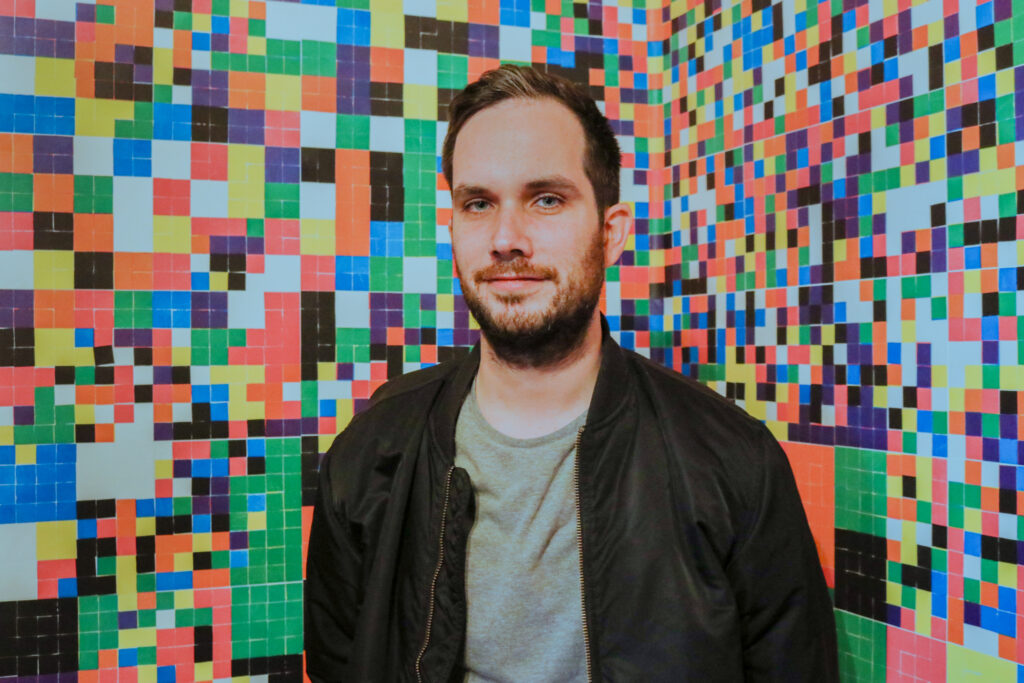Within an expanding field of expression, the art world is boundless, offering a chance for up-and-coming creators to discover new styles and artistic mediums. However, this expansion presents an ongoing debate between those who believe physical art is more or less valuable than its digital counterpart.
Noah Matteucci, WSU Vancouver’s fine arts technician, proves both digital and physical art can coexist in the same space. Within his latest installation “random (8),” at Portland’s Agenda gallery, on display from Nov. 13 to Dec. 12, Matteucci incorporated woodblocks to produce colorful, technologically-designed squares displayed on the gallery’s walls.
Matteucci combines the practice of relief printmaking, a technique used to transfer designs from one medium to another, with digital technology. He uses open-source coding to design the physical pixel block layout, and through implementing code, Matteucci can create infinite arrangements of blocks. The code assigns each block with a random function, allowing him to determine the different positions, sizes and colors of many squares.

(Emily Baumann/The VanCougar)
Matteucci then takes woodblocks and rolls different colors of ink onto their surfaces. After the ink is applied, he places the blocks onto a press, and positions paper over the top, leading him to the final process of feeding both the block and paper through the press and transferring the final design onto paper.
“The pressure of the press is hitting the paper, and then it’s hitting the ink on the woodblock, transferring it to the plate paper when it comes out of the press,” Matteucci said.
Spending his time creating analog works in painting classes throughout college, Matteucci felt pressure to constantly come up with content and ideas for his previous work. But, after joining a printmaking class, he discovered his love for the medium and grew to appreciate the community of artists involved in printmaking.
“Suddenly, we started talking about the process, and it got technical. I gravitated towards that because I didn’t have to worry about what I made,” Matteucci said. “The print studio is super collaborative. It’s one of the only mediums where you need the studio to make work because people can’t afford large presses on their own. So, people need to be there, and it’s active.”
Matteucci says he values the creative process just as much as the final product. His work intentionally questions the notion of “original” artwork, claiming that everything is unique, even his repeated digital blocks.
“In printmaking, there’s no such thing as an original. You print an addition, then every print is original in that way. In painting, you’ll have the original painting, [in] print you’ll have a series of prints and none of them are original. Each of them are unique,” Matteucci said. “I’ve always questioned the notion of originality or someone coming up with an idea and that’s the first time it’s [been brought up]. I disagree with that, I think the notion of the source or the origin of something, is evolving.”
When asked about the inspiration behind his work, Matteucci is influenced by many philosophers who discuss the nature of change. In his artist statement, he includes an analogy written by the Greek philosopher, Heraclitus, stating, “Just as the river where I step is not the same, and is, so I am as I am not.”
“Heraclitus’ aphorism [says you] can’t step in the same river twice because it’s constantly moving,” said Matteucci. “Things are in constant flux. I think we’re always evolving and changing.”
While digital art grows in popularity, Matteucci believes people are still more receptive to physical work and continue to ignore the creativity and effort behind digital creations.
“I think people fetishize handmade things a lot. [People might think] ‘someone spent a lot of time on this so it must be good.’ So, I feel like people look down on digital images over analog images. That’s unfortunate. People are more receptive to my analog prints than they are to my digital prints for sure.” Matteucci said.
Artists continue to form innovations of creativity and refuse to remain static. Although some may denounce the incorporation of technology within the greater art community, Matteucci hopes to express how analog and digital practices can mutually coincide together.

Emily is a senior studying integrated strategic communication at WSU Vancouver.
